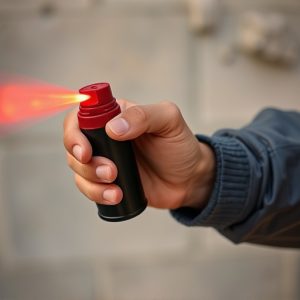Pepper Spray Potency by Brand: Legal Safety Protocols for Law Enforcement
Understanding Pepper Spray Potency by Brand is essential for effective and safe riot control. Top br…….
Understanding Pepper Spray Potency by Brand is essential for effective and safe riot control. Top brands like Olan and Pepperball offer high-potency pepper spray with capsaicin concentrations exceeding 2 million SCU, ideal for swift immobilization in critical incidents. Lesser-known brands provide moderate potencies around 1 million SCU, suitable for crowd control without prolonged discomfort. Law enforcement agencies balance public safety and individual rights by selecting appropriate agents based on risk and crowd dynamics, adhering to legal frameworks, safety protocols, protective gear, ventilation, and de-escalation tactics to mitigate adverse effects of pepper spray.
Riot control agents, a powerful tool in law enforcement, play a crucial role in managing civil unrest. This article dissects the world of these agents, focusing on understanding their types and effects. We delve into the specific analysis of pepper spray potency by brand, examining key legal considerations and safety protocols that govern their use. By exploring these aspects, we aim to provide a comprehensive guide for law enforcement professionals navigating riot control agent deployment.
- Understanding Riot Control Agents: Their Types and Effects
- Pepper Spray Potency: A Comprehensive Brand Analysis
- Legal Considerations and Safety Protocols for Law Enforcement Use of Riot Control Agents
Understanding Riot Control Agents: Their Types and Effects
Riot control agents, also known as less-lethal weapons, are chemical compounds designed to incapacitate or disrupt individuals without causing permanent harm. These agents play a significant role in law enforcement, particularly during civil unrest, protests, or situations where crowd control is necessary. Understanding their types and effects is crucial for both officers and the public.
Pepper spray, one of the most common riot control agents, works by irritating the eyes, nose, and respiratory system, leading to temporary blindness, coughing, and difficulty breathing. The potency of pepper spray varies significantly between brands, with some producing more active ingredients per unit volume. This variation in Pepper Spray Potency by Brand underscores the importance of proper training and the use of high-quality, regulated products for effective and safe riot control.
Pepper Spray Potency: A Comprehensive Brand Analysis
Pepper spray, a non-lethal weapon widely used by law enforcement agencies and security personnel, comes in varying potencies determined by its active ingredient concentration. When discussing pepper spray potency by brand, it’s essential to understand that not all sprays are created equal. Each brand formulates their products differently, leading to variations in effectiveness and user experience.
A comprehensive analysis reveals that top brands like Olan and Pepperball offer high-potency options with capsaicin concentrations exceeding 2 million SCU (Scoville Heat Units). These powerful formulas ensure swift immobilization during critical incidents. Conversely, some lesser-known brands might provide more moderate potencies, around 1 million SCU, suitable for crowd control scenarios without causing prolonged discomfort. Brand transparency about potency levels is vital to enable law enforcement officers and users to make informed decisions based on their specific needs and operational requirements.
Legal Considerations and Safety Protocols for Law Enforcement Use of Riot Control Agents
Law enforcement agencies must adhere to strict legal considerations and safety protocols when employing riot control agents, including pepper spray, to maintain public order during civil disturbances or high-risk situations. The use of such substances is carefully regulated to balance public safety with individual rights and ensure minimal harm to both suspects and bystanders. One critical aspect is understanding the pepper spray potency by brand, as different manufacturers produce varieties with varying levels of capsaicin, the active ingredient causing irritation and temporary disability.
Officers are trained to select appropriate agents based on potential risks, crowd dynamics, and environmental factors. They must also be knowledgeable about the legal framework governing their use, including local, state, and federal laws that dictate when and how these agents can be deployed legally. Safety protocols involve wearing protective gear, ensuring proper ventilation, and employing de-escalation tactics before resorting to riot control measures. These precautions are essential in mitigating risks associated with pepper spray potency variations among brands and minimizing potential adverse effects on individuals within the vicinity.
Riot control agents, particularly pepper spray, have become indispensable tools for law enforcement in managing civil disturbances. Understanding the types, potency (as evidenced through our analysis of various brands), and legal implications of these agents is crucial for ensuring their safe and effective use. By adhering to established safety protocols, law enforcement can maximize the benefits while mitigating risks associated with riot control agent deployment. Ultimately, a balanced approach that prioritizes both public safety and respect for civil liberties is essential in today’s diverse and dynamic societal landscape.

